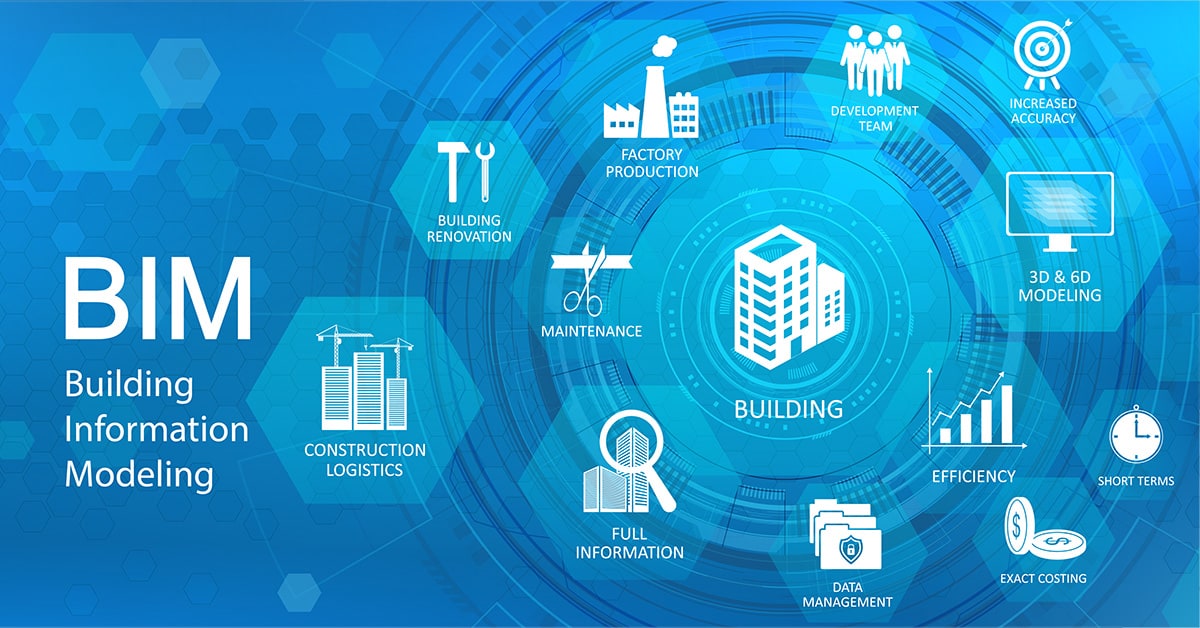
.
Omrania’s transition to BIM was as much a business decision as a technical one, with benefits and challenges on both fronts.
As mentioned in our last post that presented an overview on Building Information Modeling (BIM), it became clear to us before 2006 that BIM was going to change the Architecture, Engineering, and Construction (AEC) industry. By 2008 we were aware that in the US and UK, governments were making irreversible commitments to the transition to BIM for almost all major government-funded projects. Aware of the global implications doe the AEC industry, Omrania recognized that within a few years, this shift away from traditional design and construction practices would soon be impacted within Saudi Arabia and the wider Middle East Region. There was an undeniable timeline and investment required in learning and integrating BIM into our design, engineering, and management workflows; the potentially more significant cost in not embracing BIM technology was equally apparent. We realized that by investing time, financial resources, and energy in updating our methods of project delivery, we could unlock a multitude of direct benefits for our project teams and our clients.
The Transition
Omrania began the transition by sending a small team of architects on a 20-day seminar where they learned Autodesk Revit, today a leading 3-D modeling software application with BIM capability. That early training focused on merely learning to use the basic tools, rather than the BIM process itself. Those staff members immediately began to work on a test project to apply what they learned. This was carried out under the supervision of experienced senior Architects who ensured that the new methods produced accurate and high-quality results in the form of drawings prepared for construction. We would frequently examine what we learned, update the tools accordingly, and look for ways to streamline the entire process from design to construction. New methods of modeling and new ways of coordination soon emerged as more employees became Revit and BIM-capable, and the tool eventually became indistinguishable from the process.
The Challenges
The transition to BIM was predictably slow. We initially faced challenges related to productivity, availability of skills, and process integration. Whenever a new system is put into place, there is almost always an immediate dip in productivity. With time and investment, productivity climbed back to where it was with the original system, with the recovery of the investment made in implementing the change seen as a long-term goal. One of the significant challenges we encountered, like many others at that time did, was related to our early adoption of Revit and BIM. Arguably, the tools were not sufficiently advanced in 2006, and there were few references or successful precedents from which we could learn. This was the situation before the establishment of international standards such as NBIMS and COBie, so we struggled, as many in the industry did, to define best practices governing BIM.
Although we had some staff members dedicated to using BIM tools from the beginning, most of the more technically experienced Architects and Engineers, fearful of the impact the change might have on their performance, were reluctant to abandon established methods and familiar software. Young staff members, however, who may have been more open to experimenting with BIM, didn’t have the practical construction experience to use the software to its full advantage. A strong understanding of design and construction fundamentals is fundamental to using BIM effectively. Over time, most Senior staff have developed their understanding of BIM and Revit and now play an effective and integral part in our use of BIM.
Despite these challenges, the number of projects we completed using Revit and BIM increased steadily until, by 2015, that dedication finally paid off: improved productivity and the financial benefits of using Revit and BIM had clearly surpassed the initial productivity loss and financial investment, representing a net gain for the business and strong momentum for the future.
The Benefits
Whether building a single-family home or an entire city, BIM, once mastered, can help our Architects and Engineers design more efficiently. Indeed, the benefits of this technology have become so clear that governments across the world such as the UK are mandating the use of BIM for all taxpayer-funded projects. The UK presently requires all ‘government’ projects over £50M to be executed in BIM; by 2020, it is anticipated that the threshold will reduce to £5M. This incremental introduction is so that smaller companies have time to introduce the new technologies and absorb the associated costs.
BIM can improve coordination and communication between all invested parties. A BIM model illustrates the relationship between a building’s spaces and systems, revealing any conflicts or problems. Traditionally, these issues might have resulted in errors or omissions in the contract documents, leading to cost extras and potential delay during the construction phase. A significant advantage of BIM and the use of 3-D modeling tools is that all drawings, details, the specification, and even the bill of quantities, are derived from this shared model. With sufficient oversight during the production of the model, it becomes easier to avoid coordination errors and omissions caused by a lack of coordination between disciplines, or oversight in the completeness of the scope described within the documents.
In addition to generating graphical representations of building elements, BIM models also manage data associated with each element within the building. This data and the model are updated automatically as changes are made to the model. BIM, therefore, makes it unnecessary to recreate and interpret information each time it is handed off between participants; significantly reducing the risk of errors, omissions, or misinterpretations.
The use of plug-in app’s, BIM data can be used to simulate and optimize various aspects of a proposed building’s performance characteristics such as structural, thermal, acoustic, lighting, and fire performance. If required, Health and safety data can be exported from models, assisting in providing very comprehensive health and safety plan during construction. Relatively small improvements in understanding energy consumption can have far-reaching benefits, as a building’s operation and maintenance costs represent the greatest proportion of its total lifecycle cost. BIM can also help both bidders and the eventual successful contractor optimize construction planning, scheduling, sequencing, and management.
BIM has revolutionized cost monitoring. Systems such as the UK’s COBie now require full life cycle costing to be presented by developers supplying buildings for government agencies. BIM software allows accurate projections of total life-cycle costs and costs in use; this is vital information for P3 bidders whose competitiveness of lease rate bid over long lease durations can win or lose major projects. The same principles of data management within BIM also allow the total carbon impact of a project over its lifecycle to be evaluated. Again, the UK’s COBie system sets carbon targets for projects across their lifecycle that must be met by the developer.
Where contracts allow, assemblies and components within the BIM model may be exported directly by manufacturers for fabrication, reducing the need for separate show drawings. This information may be used in a modified form by such machinery as C&C Cutters or other fabrication lines where digital information may be utilized. This aspect of BIM remains controversial as liability for coordination of information remains with the contractor and supplier whether they use BIM data provided to them by a consultant or not. Similarly, errors or conflicts within a BIM model might be used as a reason for delay by contractors. For this reason, the use of formal and legally binding BIM contracts as part of the tender documents is essential. These clearly define expectations for what level of development (LOD) might be expected from the model. Informal or poorly defined use of BIM data during or after tender can result in significant costs and delays.
Since 2015, Omrania has used BIM tools on all new projects. With Saudi Arabia and Jordan yet to define a national policy on the implementation of BIM, we have adopted and pursued the US NBIMS model, as well as the UK’s BIM Level 2. We are ensuring data entry meets a generic COBie standard. Drawings are produced to industry standard LOD’s at key stages of the design and production process. In every proposal, we offer our BIM capabilities as standard in the event a client wishes to pursue a formal BIM process. We foresee a significant increase in demand for such capabilities with the increasing use of P3 models of development.
We are developing our capabilities to output and input data as needs demand. This may include the input of point cloud survey data, energy modeling, cost, and quantities monitoring, linked preparation of specifications and potential output of health and safety data for our site supervision teams. Our networked hardware resources have been developed commensurately with these demands with our three offices now able to operate seamlessly together.
We are not alone in these endeavors. BIM works best when more project participants use it. That’s why Omrania has been active in developing a community of users in the Middle East Region — by participating in conferences and helping to establish training programs for new users. This approach where major companies lead the way for the industry as a whole is one that has been adopted both in the US and the UK, where the incremental introduction of BIM is now reaching the second level of its implementation; with only the smaller players in the AEC industry remaining to undertake the conversion process. Now more than ever, the benefits of BIM are increasingly seen to outweigh the costs.
In Middle Eastern Markets, we have yet to see the process to define a national or regional standard for BIM progressed. We do see requests for the use of BIM in a few commercial sector RFP’s, but for the most part, standards for the use of BIM are not clearly defined or referenced. We are aware that several of the larger Contracting companies in Saudi Arabia are BIM capable at this time. If the benefits of BIM are to be realized, it is essential that the alignment of standards amongst the larger consulting and contracting businesses be discussed before they evolve too far. This is particularly important if BIM is to play an effective role in the kind of strategic partnerships required in the PPP program.







